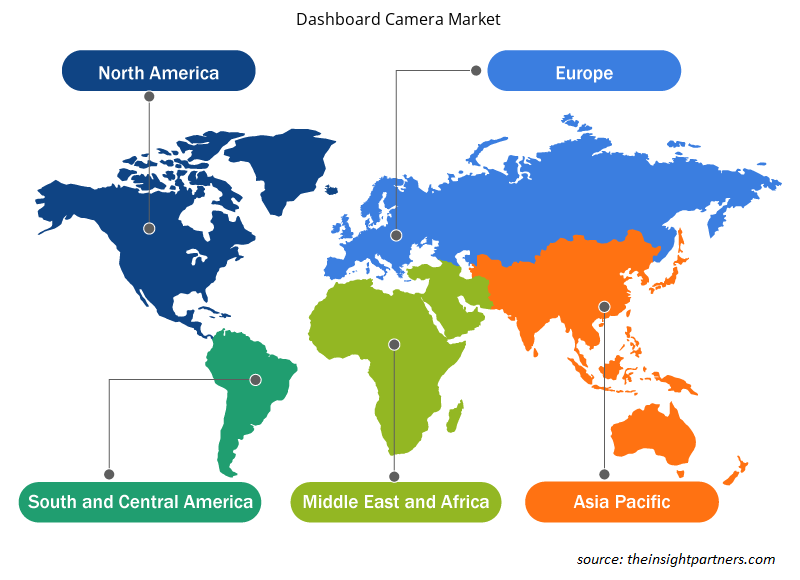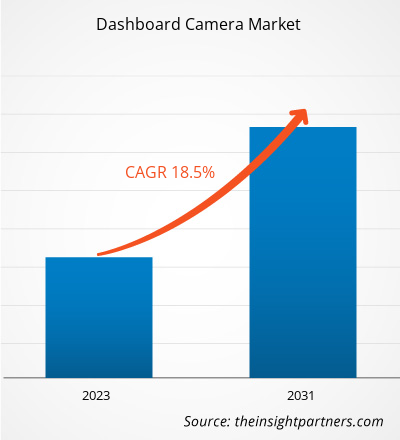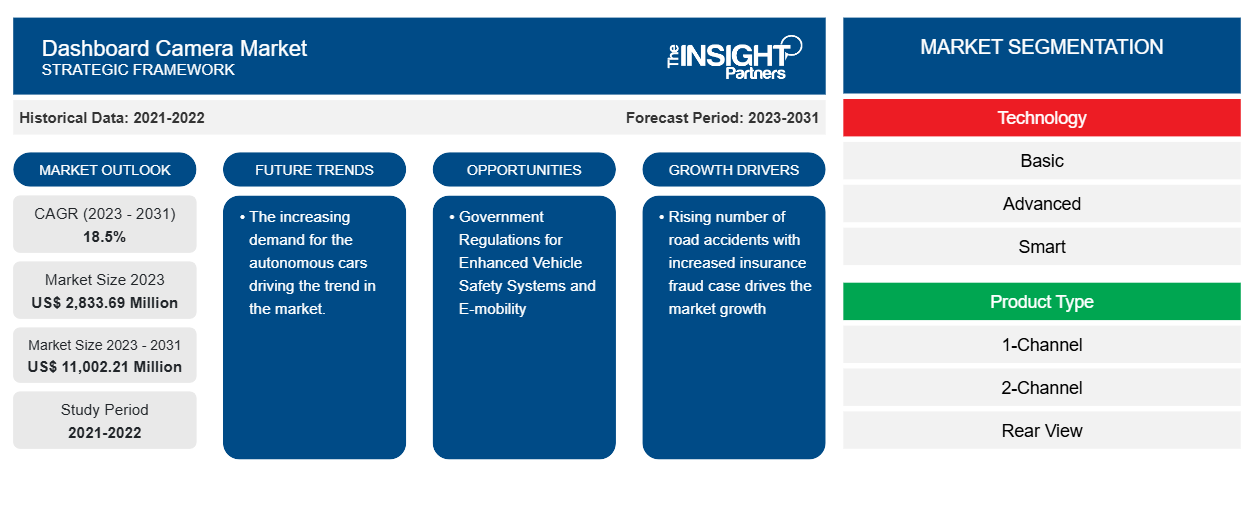Le marché des caméras de tableau de bord devrait atteindre 11 002,21 millions USD d'ici 2031, contre 2 833,69 millions USD en 2023. Le marché devrait enregistrer un TCAC de 18,5 % au cours de la période 2023-2031. La demande croissante de voitures autonomes stimule la tendance du marché.CAGR of 18.5% during 2023–2031. The increasing demand for the autonomous cars driving the trend in the market.
Analyse du marché des caméras de tableau de bord
La fréquence croissante des vols de voitures et des accidents de la route dans le monde a fait grimper la demande de produits au cours des dernières années. Les caméras embarquées peuvent également aider à éviter la fraude à l'assurance, comme le fait de causer délibérément des dommages au véhicule pour obtenir de fausses déclarations d'assurance. Les réformes réglementaires soutenant l'installation de caméras embarquées dans les voitures pour des mesures de sécurité dans de nombreux pays, dont les États-Unis, le Royaume-Uni et la Russie, ont également contribué à générer des revenus. Par exemple, les caméras embarquées sont légales aux États-Unis, car leur installation n'entrave ni n'enfreint aucune loi. Plusieurs fournisseurs d'accessoires automobiles de premier plan intègrent le système ADAS (Advanced Driver Assistance System) à la caméra embarquée. Par exemple, Harman International propose la HARMAN smart/auto VISION, une caméra embarquée ADAS connectée pour automobile qui intègre des caméras embarquées, y compris les vues avant et orientée vers le conducteur. La caméra embarquée permet des fonctions de surveillance à distance du véhicule qui prennent en charge la commande vocale, les alertes contextuelles, les avertissements de distraction et de somnolence du conducteur, les avertissements de sortie de voie et de collision et la détection des piétons.
Aperçu du marché des caméras de tableau de bord
De nombreuses caméras de tableau de bord ou dashcams sont orientées vers l'avant et pointent vers l'extérieur depuis derrière le pare-brise pour que la vidéo corresponde à la vue du conducteur. Plusieurs caméras de tableau de bord enregistrent l'action du conducteur en faisant face vers l'arrière et en visant l'intérieur du véhicule. Les caméras de tableau de bord pour flottes sont souvent liées à un logiciel de gestion de flotte, donnant aux organisations un accès en temps réel aux enregistrements des incidents de conduite du conducteur, tels que la conduite risquée ou distraite. Les caméras de tableau de bord profitent aux entreprises en réduisant les accidents, en augmentant les chances de réduire les primes d'assurance, en augmentant la rétention des conducteurs, en réduisant les coûts de carburant et l'impact sur l'environnement, en diminuant les coûts de propriété grâce à des frais de réparation et d'entretien inférieurs et en offrant une protection contre les incidents. L'écosystème du marché des caméras de tableau de bord comprend les parties prenantes suivantes : fournisseurs de matériel/composants, fabricants de caméras de tableau de bord, intégrateurs de systèmes et utilisateurs finaux. Les principaux acteurs occupent des places importantes dans les différents nœuds de l'écosystème du marché des caméras de tableau de bord. Les fournisseurs de matériel/composants fournissent les composants électriques qui sont évalués pour les températures requises, les accéléromètres , les capteurs de mouvement, le capteur de caméra, l'adhésif puissant, le processeur et le GPS, entre autres. Les constructeurs automobiles du marché mondial des caméras embarquées effectuent divers processus tels que la conception, l'assemblage et la transformation des matières premières en produits finis. Les intégrateurs de systèmes rassemblent les sous-systèmes de composants pour garantir leur fonctionnement efficace.
Personnalisez ce rapport en fonction de vos besoins
Vous bénéficierez d'une personnalisation gratuite de n'importe quel rapport, y compris de certaines parties de ce rapport, d'une analyse au niveau des pays, d'un pack de données Excel, ainsi que de superbes offres et réductions pour les start-ups et les universités.
-
Obtenez les principales tendances clés du marché de ce rapport.Cet échantillon GRATUIT comprendra une analyse de données, allant des tendances du marché aux estimations et prévisions.
Facteurs moteurs et opportunités du marché des caméras de tableau de bord
L'augmentation du nombre d'accidents de la route et des cas de fraude à l'assurance stimule la croissance du marché
Le nombre croissant d’accidents de la route, de vols de voitures et de fraudes à l’assurance a accru la demande pour le marché mondial des caméras de tableau de bord. De plus, les politiques favorables des gouvernements et des compagnies d’assurance visant à offrir des remises aux voitures équipées de caméras de tableau de bord devraient offrir des opportunités importantes aux entreprises qui envisagent d’entrer sur ce marché. Le nombre d’accidents de la route augmente depuis la dernière décennie avec l’augmentation du nombre de véhicules sur les routes urbaines et sur autoroutes. Selon un rapport de l’Organisation mondiale de la santé (OMS), chaque année, environ 1,3 million de personnes perdent la vie à cause d’accidents de la circulation. Les blessures non mortelles touchent environ 20 à 50 millions de personnes chaque année, entraînant une invalidité et une perte de revenus conséquente. Les particuliers, les familles et les économies nationales subissent des pertes économiques importantes en raison des accidents de la route
Réglementations gouvernementales pour les systèmes de sécurité améliorés des véhicules et la mobilité électrique
Les caméras embarquées de haute technologie disponibles sur le marché utilisent la vision par ordinateur et l'intelligence artificielle pour évaluer les enregistrements vidéo, ce qui leur permet de mieux comprendre les activités du conducteur, telles que l'utilisation du téléphone portable, l'alimentation et la fatigue au volant. En août 2021, KeepTruckin, leader du marché des technologies de gestion de flotte, a lancé une nouvelle caméra embarquée IA alimentée par un processeur IA sophistiqué et des algorithmes de vision par ordinateur intelligents pour détecter instantanément une conduite dangereuse avec une précision inégalée et alerter les conducteurs en temps réel. Une plate-forme de sécurité avancée prend en charge les caméras embarquées, ce qui conduit à une transformation de la gestion de flotte et à une sécurité accrue du conducteur. De même, la caméra embarquée de haute technologie Nextbase 522GW intègre un mode de stationnement intelligent pour l'enregistrement automatique si des bosses ou des mouvements sont détectés sur le véhicule. L'appareil comprend également un écran IPS HD de 3 pouces avec lecture intégrée à Alexa, partage facile et sélection de menu.
Analyse de segmentation du rapport sur le marché des caméras de tableau de bord
Les segments clés qui ont contribué à l’élaboration de l’analyse du marché des caméras de tableau de bord sont la technologie, le type de produit, la qualité vidéo, l’application et la géographie.
- En fonction de la technologie, le marché est divisé en deux catégories : basique, avancée et intelligente. Parmi celles-ci, la technologie de base devrait détenir la plus grande part en 2023, en raison de son adoption accrue dans les voitures particulières.
- Selon le type de produit, le marché est divisé en 1 canal, 2 canaux et vue arrière. La vue arrière est elle-même segmentée en vue avant et vue arrière
- En fonction de la qualité vidéo, le marché est divisé en SD et HD, et Full HD et 4K. Parmi ceux-ci, SD et HD détiennent la plus grande part en 2023, en raison de la demande accrue à travers le monde pour la production de voitures particulières et de véhicules utilitaires.
- Selon l'application, le marché est divisé en véhicules utilitaires et véhicules personnels. Parmi ceux-ci, les véhicules personnels occupent la plus grande part en 2023, en raison de l'adoption croissante de leurs véhicules par les consommateurs.
Analyse des parts de marché des caméras de tableau de bord par zone géographique
La portée géographique du rapport sur le marché des caméras de tableau de bord est principalement divisée en cinq régions : Amérique du Nord, Asie-Pacifique, Europe, Moyen-Orient et Afrique, et Amérique du Sud et centrale.
L'Asie-Pacifique détient la plus grande part du marché des caméras de tableau de bord en raison de l'augmentation des ventes de véhicules électriques dans cette région. L'augmentation de la demande des consommateurs pour des fonctionnalités coûteuses dans les automobiles encourage les fabricants à investir dans des solutions technologiques haut de gamme. L'industrie automobile a été la première victime économique du COVID-19 en Chine avec la fermeture des principaux sites de production et usines de fabrication automobiles. Le marché automobile de la région Asie-Pacifique a continué de rebondir fortement en 2021. Les experts du secteur s'attendent à ce que les marges des constructeurs automobiles s'améliorent au cours de l'exercice 22. Le rebond du marché encourage la croissance des solutions de caméras de tableau de bord. Dans la plupart des pays, les subventions sont un outil essentiel pour maintenir la politique des véhicules électriques en raison de la hausse des coûts des véhicules. Le gouvernement japonais a organisé 77,1 millions de dollars de subventions pour les véhicules électriques en janvier 2021 pour stimuler les ventes de véhicules électriques. Un certain nombre de nouvelles sociétés de capital-risque émergent sur le marché des véhicules électriques en Chine, au Japon et en Corée du Sud, ce qui devrait offrir des opportunités de croissance lucratives pour le marché des caméras de tableau de bord.
Aperçu régional du marché des caméras de tableau de bord
Les tendances régionales et les facteurs influençant le marché des caméras de tableau de bord tout au long de la période de prévision ont été expliqués en détail par les analystes d’Insight Partners. Cette section traite également des segments et de la géographie du marché des caméras de tableau de bord en Amérique du Nord, en Europe, en Asie-Pacifique, au Moyen-Orient et en Afrique, ainsi qu’en Amérique du Sud et en Amérique centrale.

- Obtenez les données régionales spécifiques au marché des caméras de tableau de bord
Portée du rapport sur le marché des caméras de tableau de bord
| Attribut de rapport | Détails |
|---|---|
| Taille du marché en 2023 | 2 833,69 millions de dollars américains |
| Taille du marché d'ici 2031 | 11 002,21 millions de dollars américains |
| Taux de croissance annuel composé mondial (2023-2031) | 18,5% |
| Données historiques | 2021-2022 |
| Période de prévision | 2023-2031 |
| Segments couverts |
Par technologie
|
| Régions et pays couverts |
Amérique du Nord
|
| Leaders du marché et profils d'entreprises clés |
|
Densité des acteurs du marché : comprendre son impact sur la dynamique des entreprises
Le marché des caméras de tableau de bord connaît une croissance rapide, tirée par la demande croissante des utilisateurs finaux en raison de facteurs tels que l'évolution des préférences des consommateurs, les avancées technologiques et une plus grande sensibilisation aux avantages du produit. À mesure que la demande augmente, les entreprises élargissent leurs offres, innovent pour répondre aux besoins des consommateurs et capitalisent sur les tendances émergentes, ce qui alimente davantage la croissance du marché.
La densité des acteurs du marché fait référence à la répartition des entreprises ou des sociétés opérant sur un marché ou un secteur particulier. Elle indique le nombre de concurrents (acteurs du marché) présents sur un marché donné par rapport à sa taille ou à sa valeur marchande totale.
Les principales entreprises opérant sur le marché des caméras de tableau de bord sont :
- Technologie ABEO
- Garmin Ltd
- Pittasoft Co. Ltd
- Falcon Electronics LLC
- Société Panasonic
- Cobra Electronics Co
Avis de non-responsabilité : les sociétés répertoriées ci-dessus ne sont pas classées dans un ordre particulier.

- Obtenez un aperçu des principaux acteurs du marché des caméras de tableau de bord
Actualités et développements récents du marché des caméras de tableau de bord
Le marché des caméras de tableau de bord est évalué en collectant des données qualitatives et quantitatives après des recherches primaires et secondaires, qui comprennent d'importantes publications d'entreprise, des données d'association et des bases de données. Quelques-uns des développements du marché des caméras de tableau de bord sont répertoriés ci-dessous :
- Delphi annonce le lancement de sa nouvelle gamme de plaquettes de frein BEV dédiées aux besoins spécifiques des applications BEV. Sur la base de comparaisons détaillées, cette gamme est parmi les plus complètes au monde aujourd'hui, couvrant les modèles les plus populaires sur le marché des pièces de rechange indépendantes. Les véhicules comprennent la Nissan Leaf et la Tesla Model S/Model 3, en plus des modèles les plus récents tels que la BMW i4/iX, la Mercedes EQC/EQEE/QS et la Porsche Taycan/Cross Turismo. En introduisant 52 numéros de pièces couvrant 2,7 millions de véhicules en exploitation en Europe, Delphi offre une opportunité de service substantielle aux ateliers. (Source : site Web de l'entreprise, février 2024)
- Allied Nippon a lancé EV+, une toute nouvelle gamme de plaquettes de frein complètes pour véhicules électriques. (Source : communiqué de presse, juin 2023)
Rapport sur le marché des caméras de tableau de bord et livrables
Le rapport « Taille et prévisions du marché des caméras de tableau de bord (2021-2031) » fournit une analyse détaillée du marché couvrant les domaines ci-dessous :
- Taille et prévisions du marché des caméras de tableau de bord aux niveaux mondial, régional et national pour tous les segments de marché clés couverts par le champ d'application
- Tendances du marché des caméras de tableau de bord ainsi que la dynamique du marché telles que les facteurs déterminants, les contraintes et les opportunités clés
- Analyse PEST et SWOT détaillée
- Analyse du marché des caméras de tableau de bord couvrant les principales tendances du marché, le cadre mondial et régional, les principaux acteurs, les réglementations et les développements récents du marché
- Analyse du paysage industriel et de la concurrence couvrant la concentration du marché, l'analyse de la carte thermique, les principaux acteurs et les développements récents pour le marché des caméras de tableau de bord
- Profils d'entreprise détaillés
- Analyse historique (2 ans), année de base, prévision (7 ans) avec TCAC
- Analyse PEST et SWOT
- Taille du marché Valeur / Volume - Mondial, Régional, Pays
- Industrie et paysage concurrentiel
- Ensemble de données Excel
Rapports récents
Rapports connexes
Témoignages
Raison d'acheter
- Prise de décision éclairée
- Compréhension de la dynamique du marché
- Analyse concurrentielle
- Connaissances clients
- Prévisions de marché
- Atténuation des risques
- Planification stratégique
- Justification des investissements
- Identification des marchés émergents
- Amélioration des stratégies marketing
- Amélioration de l'efficacité opérationnelle
- Alignement sur les tendances réglementaires























 Obtenez un échantillon gratuit pour - Marché des caméras de tableau de bord
Obtenez un échantillon gratuit pour - Marché des caméras de tableau de bord